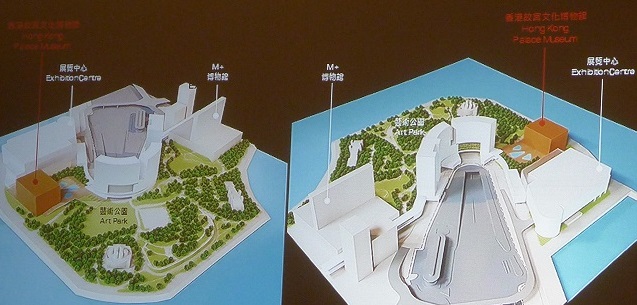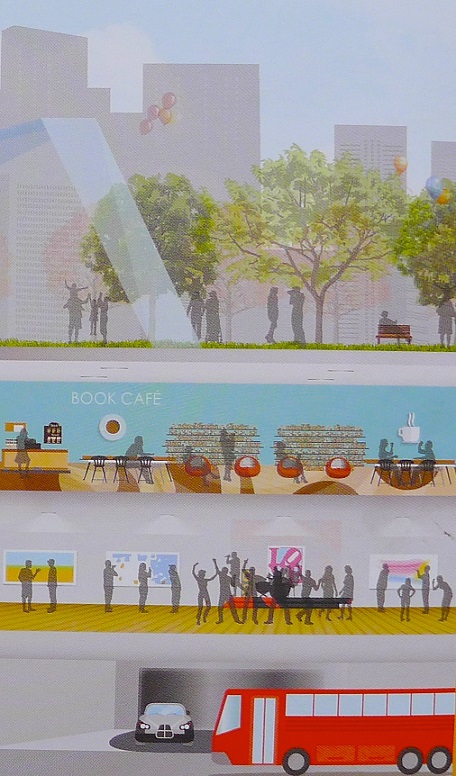藝評
除非毗鄰故宮文化博物館,否則一切往地下發展 ∣ Underground, Unless It’s Next to the Palace Museum
約翰百德 (John BATTEN)
at 3:14pm on 22nd February 2017


Captions:
1. Two images showing proposed Palace Museum and above-ground Exhibition Centre from different viewpoints.
2. Funky, cartoon-style government image showing potential underground facilities, but not showing destruction of grass parkland with such infrastructure as escalators and ventilation buildings.
(Please scroll down for English version)
土木工程拓展署剛展開另一項引起爭議的政府建議。署方建議發展香港市區公園,特別是銅鑼灣維多利亞公園、灣仔修頓球場和尖沙咀九龍公園, 署方的地下空間發展第一階段公眾參與剛於二月初結束。
根據土木工程拓展署的資料,發展地下空間,是為了提供額外行人通道、改善生活環境和創造空間。土木工程拓展署在討論文件中提及多項主要考慮,包括「土力、結構和基建設施的限制」、「消防安全」、「財務可行性」和「對地面設施與活動的影響」。上述各項都似乎是非常嚴重的「限制」,但卻輕易地在諮詢文件中擱在一旁,完全沒有提供任何技術資料或正反論據來幫助和邀請市民發表意見!
無論對任何地點進行研究,都需要考慮整個建築環境。規劃需要全面,而非零零碎碎地推展,也須包括路面管理事宜。例如,土木工程拓展署發現崇光百貨外十字路口出現行人擠迫的情況, 但卻沒有就此問題展開全面討論,反而讓討論重點直接落在維園草地和銅鑼灣及天后兩個港鐵站如何透過地下行人通道與其他設施(包括泊車)相連。崇光百貨外行人熙來攘往的擠迫情況,不可能由任何維園的地下發展得到改善!
同樣地,土木工程拓展署也認為九龍公園是一個「障礙」,因為它分隔了廣東道和彌敦道,署方建議利用地下行人通道和九龍公園內的發展來改善海防道行人路面擠塞問題。然而,海防道所以擠迫,只因為它是廣東道和彌敦道之間唯一一條地面通道。類似女青年會旁的行人隧道並不受市民觀迎,行人較喜愛在地面橫過馬路。其實署方只需在彌敦道近公園沿路設置更好的路標,鼓勵行人打道公園,便可以改善海防道的行人擠迫情況,改善可以如此簡單!這條行人路線相對上直接,而且可以更悠閒地往來尖沙咀兩邊。
但是,諮詢卻向地下空間發展方面傾斜。興建地下建築只有在採用明挖法才在財政上可行。換言之,挖掘需要在地面進行,最理想是空曠範圍,即那些沒有建築物的範圍。那便只餘我們公園裡的草地和露天空間了!要在公園內進行建築工程,意味它們會長時間關閉。除了停車場以外,可以與地下行人步道一同興建的可行設施便只有商店。香港早已有足夠的零售空間,你可以看看全港的吉鋪情況。零售已不再是首選的發展選項,時代早已不同了。
但是次諮詢最令人難以接受的一點,是我們綠草如茵的公園被考慮作發展用途。我們的公園是用來散步、遊玩和休憩用的,不應該作為收入來源考慮。我們的公園並不是財政資產,而是讓人放鬆的地方。它們是為市民而興建的。尖沙咀、灣仔和銅鑼灣都是人多擠迫的地方,所以任何改善都應該旨在為市民改善地面環境,而不是讓車輛有更方便的駕駛環境!地底設施當然可以為空間增加寶貴價值。現時,超過三份一的銅鑼灣物業已有使用本身的地下空間。但是,對市區公園來說卻沒有足夠道理。其他受這些計劃威脅的綠色範圍,還包括跑馬地馬場,和鄰近大球場及灣仔運動場的綠色空間。
然而,諷刺的是政府對地下空間有不同的考慮。西九龍文化區便曾有過在擬建故宮文化博物館的位置興建大型表演場地的規劃。這個大型表演場地類似紅磡體育館,可容納15,000名觀眾。最初的建議中,大型表演場地也包括一個龐大的「地下」展覽中心。贏得整個文化區總體規劃設計的建築師事務所Foster+Partners解釋指,大型表演場地和地下展覽中心,可以「在同一個緊湊的空間內匯聚兩個互相兼容的功能」。 然而,當林鄭月娥宣佈擬建故宮文化博物館時,展覽中心在沒有任何解釋下,出現到地面上:一個龐大的建築在故宮文化博物館旁雄踞,佔據著坐擁維港景色、原本是公園用地的珍貴地面空間。地下現在有些什麼?停車場,儘管鄰近已有三個港鐵站和多條巴士路線。這種道路基建的支援,只會令區內交通擠塞的情況加劇。而且,這些最新修改在毫無「公眾參與」以前已完成。
參考資料:
保護市區公園大聯盟臉書
城市地下空間發展:策略性地區先導研究網站
原文刊於《明報周刊》,2017年2月18日。
Underground, Unless It’s Next to the Palace Museum
John Batten
Another contentious government proposal has just been initiated by the Civil Engineering and Development Department (CEDD). Plans to develop our urban parkland and especially Victoria Park in Causeway Bay, Southorn Playground in Wan Chai and Kowloon Park in Tsim Sha Tsui have been mooted in the Department’s initial “Public Engagement of Underground Space Development” which ended in early February.
According to the CEDD, the reasons for developing underground space is to assist “improving pedestrian connectivity, enhancing the living environment and creating space.” “Key considerations” are mentioned in the CEDD’s discussion paper, including such obstacles as “geotechnical, structural and infrastructural constraints”, “fire safety”, “financial viability” and the “impact to above-ground facilities and activities.” These appear to be very serious “constraints”, but are breezily set aside in the consultation paper, and without any technical information or arguments for-or-against to help form an opinion, the public is invited to make suggestions!
When studying any place, the entire built environment needs to be considered. It must be seen holistically, not done in a piecemeal fashion and must include road management. For example, the CEDD identifies the congested pedestrian intersection outside SOGO, but rather than initiating a full discussion about this particular problem, the CEDD’s discussion jumps to focus on the grassed area of Victoria Park and how the MTR stations of Causeway Bay and Tin Hau can be linked by an underground pedestrian passage and other facilities, including carparking. The solution to pedestrian congestion outside SOGO will not improved by any underground development in Victoria Park!
Likewise, the CEDD identifies Kowloon Park as being a ‘barrier’ because it blocks free movement between Canton Road and Nathan Road and suggests that pedestrian congestion on Haiphong Road can be improved by underground passages and development in Kowloon Park. Haiphong Road, however, is only crowded because it is the only ground-level connection between Canton Road and Nathan Road. Pedestrian underpasses, such as the one next to the YMCA, are not popular; pedestrians prefer to cross roads at ground-level. And with better signage along the park side of Nathan Road – such a simple improvement! – pedestrian congestion can be relieved on Haiphong Road by encouraging pedestrians to walk through the park. This pedestrian route would be relatively direct, and much more leisurely, to get from either side of Tsim Sha Tsui.
But, the consultation is biased towards the development aspect of underground space development. Building underground is only financially viable if an open-cut method of excavation is used. That means excavation is done at ground-level and best done in areas that are open; areas without buildings and trees. That leaves the grassed and open areas of our parks! Any construction in the parks would mean they would be closed for years to allow construction. And the only viable facilities, apart from carparking, that could be built along underground pedestrian walkways would be shops. We already have enough retail areas in Hong Kong – and just look at the number of vacant shops throughout Hong Kong. Retail is no longer a default development option; times are different.
But the most unacceptable aspect of this consultation is that our green, grassed parks are being considered for development. Our parks are for walking and playing and recreation. They should never be considered as sources of revenue. Our parks are not financial assets – they are places for people and leisure. People and relaxation. They are for people. Tsim Sha Tsui, Wan Chai and Causeway Bay are crowded places and any improvements should aim to make their ground-level environment better for people – and, not an easier driving environment for cars! Underground facilities, of course, can be a valuable addition to space. Currently, more than a third of Causeway Bay properties already use their underground space. But, it is not justified in our urban parks. Other green areas under threat by these plans include Happy Valley Racecourse, green spaces near Hong Kong Stadium and Wan Chai Sports Ground.
Ironically, however, some underground spaces are considered differently by the government. In the West Kowloon Cultural District, the proposed Palace Museum is to be built where a Mega Performance Venue (MPV) - a large concert venue, similar to the Coliseum, capable of seating 15,000 people - had previously been planned. Originally, the MPV also comprised a large underground Exhibition Centre. Foster+Partners, the architects that won the West Kowloon Cultural District Master Plan design, explained that having the MPV with an underground Exhibition Centre was “bringing two compatible functions together within one compact form.” However, when Carrie Lam announced the proposed Palace Museum, the Exhibition Centre was, without explanation, now located above ground: a huge structure dominating the adjacent Palace Museum and taking valuable ground-level space that has Harbour views and originally intended to be parkland. And, what is underground now? Car-parking, despite three MTR stations and buses nearby. This support for such road infrastructure will only worsen traffic congestion in the area. And, these latest changes were done without any “public engagement”!
Links for further info:
Save Our Urban Parks Alliance facebook
Pilot Study on Underground Space Development in Selected Strategic Urban Areas website
This essay was originally published in Ming Pao Weekly, 18 February 2017.
|
|
|
|
|
|
